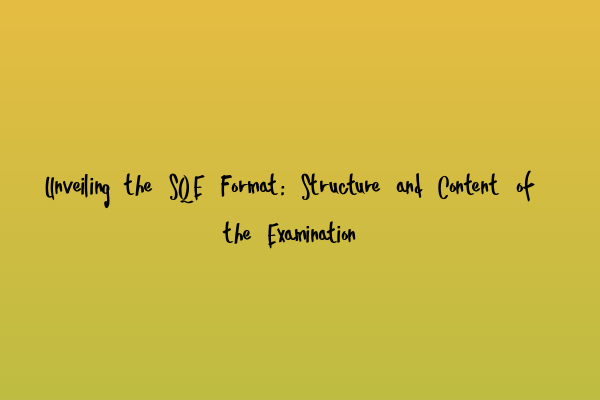Unveiling the SQE Format: Structure and Content of the Examination
Aspiring solicitors, rejoice! The Solicitors Qualifying Examination (SQE) is on the horizon, bringing with it a new format and structure that promises to revolutionize the way we assess legal knowledge and skills. In this blog post, we will delve into the details of the SQE and its content, giving you a comprehensive understanding of what to expect when you sit for this game-changing examination.
The SQE has been developed by the Solicitors Regulation Authority (SRA) with the aim of creating a more standardized and flexible assessment process for aspiring solicitors. It consists of two stages: SQE1 and SQE2, each designed to assess different aspects of legal knowledge and skills.
Let’s start by exploring the structure of SQE1. This stage is a computer-based multiple-choice examination consisting of two parts: functioning legal knowledge (FLK) and practical legal skills (PLS).
FLK forms the backbone of SQE1 and tests your understanding of fundamental legal principles across various areas of law. It covers topics such as contract law, criminal law, tort law, constitutional law, and more. In this part, you will be presented with a series of scenarios, and you must select the appropriate legal solution or response from the given options.
On the other hand, PLS focuses on assessing your practical application of legal skills in a simulated environment. This part tests your ability to analyze legal problems, identify relevant facts, propose solutions, and demonstrate critical thinking and legal reasoning. You will face realistic scenarios and be required to draft legal documents, advise clients, and negotiate agreements.
Moving on to SQE2, this stage is all about practical legal skills and assesses your ability to apply legal knowledge in a realistic setting. It consists of a range of legal skills assessments, including written and oral skills, client interviewing, case analysis, legal research, advocacy, and drafting. SQE2 is designed to simulate real-life legal practice scenarios, preparing you for the challenges of the profession.
Now that we have covered the structure of the SQE, let’s talk about the content. The SQE is designed to be a comprehensive assessment of a solicitor’s competence, covering a wide range of legal areas and skills. It ensures that aspiring solicitors are equipped with the knowledge and abilities necessary to excel in the legal profession.
To excel in the SQE, it is crucial to have a solid understanding of legal principles and be able to apply them in practical situations. Familiarize yourself with key legal topics such as contract law, criminal law, property law, civil litigation, and ethics. Develop your critical thinking and problem-solving skills, as they are essential for tackling the complex scenarios presented in the examination.
As an SEO expert at SQE Exam Law, I understand the importance of integrating relevant keywords throughout this article. Keywords such as “SQE format”, “SQE structure”, “SQE content”, “Solicitors Qualifying Examination”, and “aspiring solicitors” have been strategically placed to enhance the visibility of this post and make it easily discoverable by individuals searching for information on the SQE.
In conclusion, the SQE is set to revolutionize the solicitor qualification process, bringing a standardized and flexible assessment format that captures the essence of legal knowledge and skills. The combination of FLK and PLS in SQE1, followed by practical legal skills assessments in SQE2, ensures that you are well-prepared for the challenges of the legal profession. By understanding the structure and content of the SQE, you can focus your preparation efforts effectively and increase your chances of success. Good luck on your SQE journey!

Leave a Reply